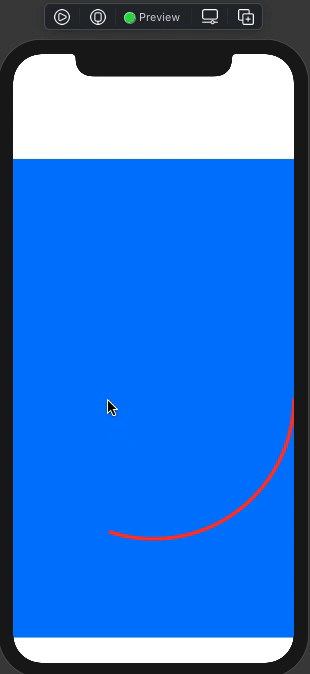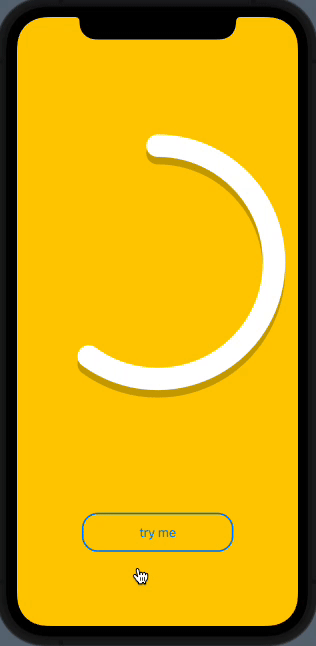ScrollView + NavigationView animation glitch SwiftUI
Setting the top padding to 1 is breaking at least 2 major things:
- The scroll view does not extend under NavigationView and TabView - this making it loose the beautiful blur effect of the content that scrolls under the bars.
- Setting background on the scroll view will cause Large Title NavigationView to stop collapsing.
I've encountered these issues when i had to change the background color on all screens of the app i was working on.
So i did a little bit more digging and experimenting and managed to figure out a pretty nice solution to the problem.
Here is the raw solution:
We wrap the ScrollView into 2 geometry readers.
The top one is respecting the safe area - we need this one in order to read the safe area insets
The second is going full screen.
We put the scroll view into the second geometry reader - making it size to full screen.
Then we add the content using VStack, by applying safe area paddings.
At the end - we have scroll view that does not flicker and accepts background without breaking the large title of the navigation bar.
struct ContentView: View {
var body: some View {
NavigationView {
GeometryReader { geometryWithSafeArea in
GeometryReader { geometry in
ScrollView {
VStack {
Color.red.frame(width: 100, height: 100, alignment: .center)
ForEach(0..<5) { i in
Text("\(i)")
.frame(maxWidth: .infinity)
.background(Color.green)
Spacer()
}
Color.red.frame(width: 100, height: 100, alignment: .center)
}
.padding(.top, geometryWithSafeArea.safeAreaInsets.top)
.padding(.bottom, geometryWithSafeArea.safeAreaInsets.bottom)
.padding(.leading, geometryWithSafeArea.safeAreaInsets.leading)
.padding(.trailing, geometryWithSafeArea.safeAreaInsets.trailing)
}
.background(Color.yellow)
}
.edgesIgnoringSafeArea(.all)
}
.navigationBarTitle(Text("Example"))
}
}
}
The elegant solution
Since the solution is clear now - lets create an elegant solution that can be reused and applied to any existing ScrollView by just replacing the padding fix.
We create an extension of ScrollView that declares the fixFlickering function.
The logic is basically we wrap the receiver into the geometry readers and wrap its content into the VStack with the safe area paddings - that's it.
The ScrollView is used, because the compiler incorrectly infers the Content of the nested scroll view as should being the same as the receiver. Declaring AnyView explicitly will make it accept the wrapped content.
There are 2 overloads:
- the first one does not accept any arguments and you can just call it on any of your existing scroll views, eg. you can replace the
.padding(.top, 1)with.fixFlickering()- thats it. - the second one accept a configurator closure, which is used to give you the chance to setup the nested scroll view. Thats needed because we don't use the receiver and just wrap it, but we create a new instance of ScrollView and use only the receiver's configuration and content. In this closure you can modify the provided ScrollView in any way you would like, eg. setting a background color.
extension ScrollView {
public func fixFlickering() -> some View {
return self.fixFlickering { (scrollView) in
return scrollView
}
}
public func fixFlickering<T: View>(@ViewBuilder configurator: @escaping (ScrollView<AnyView>) -> T) -> some View {
GeometryReader { geometryWithSafeArea in
GeometryReader { geometry in
configurator(
ScrollView<AnyView>(self.axes, showsIndicators: self.showsIndicators) {
AnyView(
VStack {
self.content
}
.padding(.top, geometryWithSafeArea.safeAreaInsets.top)
.padding(.bottom, geometryWithSafeArea.safeAreaInsets.bottom)
.padding(.leading, geometryWithSafeArea.safeAreaInsets.leading)
.padding(.trailing, geometryWithSafeArea.safeAreaInsets.trailing)
)
}
)
}
.edgesIgnoringSafeArea(.all)
}
}
}
Example 1
struct ContentView: View {
var body: some View {
NavigationView {
ScrollView {
VStack {
Color.red.frame(width: 100, height: 100, alignment: .center)
ForEach(0..<5) { i in
Text("\(i)")
.frame(maxWidth: .infinity)
.background(Color.green)
Spacer()
}
Color.red.frame(width: 100, height: 100, alignment: .center)
}
}
.fixFlickering { scrollView in
scrollView
.background(Color.yellow)
}
.navigationBarTitle(Text("Example"))
}
}
}
Example 2
struct ContentView: View {
var body: some View {
NavigationView {
ScrollView {
VStack {
Color.red.frame(width: 100, height: 100, alignment: .center)
ForEach(0..<5) { i in
Text("\(i)")
.frame(maxWidth: .infinity)
.background(Color.green)
Spacer()
}
Color.red.frame(width: 100, height: 100, alignment: .center)
}
}
.fixFlickering()
.navigationBarTitle(Text("Example"))
}
}
}
NavigationView with ScrollView has unexpected velocity (or no animation) - Large Title + ScrollView - SwiftUI - iOS 14
This issue has been solved with the Xcode Beta 4 and iOS 14 Beta 4 update.
The NavigationView() with ScrollView() can be used with no problems.
SwiftUI: Broken explicit animations in NavigationView?
Here is fixed part (another my answer with explanations is here).
Tested with Xcode 12 / iOS 14.

struct EscapingAnimationTest_Inner: View {
@State var degrees: CGFloat = 0
var body: some View {
Circle()
.trim(from: 0.0, to: 0.3)
.stroke(Color.red, lineWidth: 5)
.rotationEffect(Angle(degrees: Double(degrees)))
.animation(Animation.linear(duration: 1).repeatForever(autoreverses: false), value: degrees)
.onAppear() {
DispatchQueue.main.async { // << here !!
degrees = 360
}
}
}
}
Update: the same will be using withAnimation
.onAppear() {
DispatchQueue.main.async {
withAnimation(Animation.linear(duration: 1).repeatForever(autoreverses: false)) {
degrees = 360
}
}
}
SwiftUI Circle View animation glitch
It is unclear definitely, probably due to undefined size of shapes as a nature... Anyway, seems using drawing group fixes the issue.
Here is a fixed code. Tested with Xcode 13 / iOS 15.

struct CircularProgressView: View {
@Binding var progress: Float
private let strokeStyle = StrokeStyle(lineWidth: 30.0, lineCap: .round, lineJoin: .round)
private let rotation = Angle(degrees: 270.0)
var body: some View {
ZStack {
Group {
Circle()
.trim(from: 0.0, to: CGFloat(min(self.progress, 1.0)))
.stroke(style: strokeStyle)
.opacity(0.2)
.foregroundColor(Color.black)
.rotationEffect(rotation)
.offset(x: 0, y: 10)
Circle()
.trim(from: 0.0, to: CGFloat(min(self.progress, 1.0)))
.stroke(style: strokeStyle)
.opacity(1)
.foregroundColor(Color.white)
.rotationEffect(rotation)
}
.padding() // << compensate offset within own bounds
}
.drawingGroup() // << here !!
.animation(.linear, value: progress)
}
}
struct CircularProgressView_Previews: PreviewProvider {
static var previews: some View {
OtherView(progress: 0.6)
}
struct OtherView : View {
@State var progress : Float = 0.0
var body: some View {
ZStack {
Color.yellow
VStack {
CircularProgressView(progress: self.$progress)
.padding()
Button(action: {
if(progress >= 1) {
progress = 0
} else {
progress += 0.1
}
}) {
Text("try me")
.frame(width: 200, height: 50)
.overlay(
RoundedRectangle(cornerRadius: 20)
.stroke(Color.blue, lineWidth: 2)
)
.padding(.bottom, 100)
}
}
}.ignoresSafeArea()
}
}
}
Related Topics
Referring to Environment Variables in Swift
Why I Can Not Inherit from Multiple Classes in Swift Just Like It's Library Classes
In Swift, How to Cast to Protocol with Associated Type
What Is '@_Silgen_Name' in Swift Language
Scanning Real-World Object and Generating 3D Mesh from It
Uitableview Load More When Scrolling to Bottom
Order of Modifiers in Swiftui View Impacts View Appearance
Objective-C Bridging Header for Frameworks
When to Use Foreach(_:) Instead of for In
Linker Command Failed with Exit Code 1 After Installing Cocoapods and Firebase Pod
Cannot Resolve Swift Packages After 15Th March 2022 in Xcode
Firebase Converting Snapshot Value to Objects
Deep Copy for Array of Objects in Swift
Array Element Cannot Be Bridged to Objective-C
Masking an Image in Swift Using Calayer and Uiimage
Swiftui Hierarchical Picker With Dynamic Data Crashes
Uitableviewautomaticdimension Not Working for Resizing Cell Height